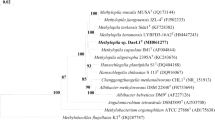Abstract
A bacterial strain utilizing methanol as the sole source of carbon and energy was isolated from the maize phyllosphere. Cells are nonpigmented gram-negative motile rods that do not form spores or prosthecae and reproduce by binary fission. The strain does not require vitamins or supplementary growth factors. It is obligately aerobic and urease-, oxidase-, and catalase-positive. The optimum growth temperature is 35–40°C; the optimum pH is 7.0–7.5. The doubling time is 2 h. The bacterium implements the ribulose monophosphate pathway and possesses NAD+-dependent 6-phosphogluconate dehydrogenase and enzymes of the glutamate cycle. α-Ketoglutarate dehydrogenase and enzymes of the glyoxylate cycle (isocitrate lyase and malate synthase) are absent. Fatty acids are dominated by palmitic (C16:0) and palmitoleic (C16:1) acids. The major phospholipids are phosphatidylethanolamine, phosphatidylglycerol, and phosphatidylcholine. Cardiolipin is present in minor amounts. The dominant ubiquinone is Q8 The bacterial genome contains genes controlling the synthesis and secretion of cytokinins. The G+C content of DNA is 57.2 mol %, as determined from the DNA thermal denaturation temperature Tm. The bacterium shows low DNA homology (<10%) with restricted facultative methylotrophic bacteria of the genusMethylophilus (M. methylotrophus NCIMB 10515T andM. leisingerii VKM B-20131) and with the obligate methylotrophic bacterium (Methylobacillus glycogenes ATCC 29475T). DNA homology with the type representative of the genusMethylovorus, M. glucosetrophus VKM B-1745T, is high (58%). The new isolate was classified as a new species,Methylovorus mays sp. nov.
Similar content being viewed by others
References
MacDonald, R.C. and Fall, R., Methanol Emission from Plants,Plant Physiol., 1992, vol. 1, no. 2, p. 427.
Fall, R., Cycling of Methanol between Plants, Methylotrophs and the Atmosphere,Microbial Growth on C 1-Compounds, Lidstrom, M.E. and Tabita, F.R., Eds., Dordrecht: Kluwer, 1996, pp. 343–350.
Austin, B. and Goodfellow, M.,Pseudomonas mesophilica, a New Species of Pink Bacteria Isolated from Leaf Surfaces,Int. J. Syst. Bacteriol., 1979, vol. 29, no. 1, pp. 373–378.
Corpe, W.A. and Rheem, S., Ecology of the Methylotrophic Bacteria on Living Leaf Surfaces,FEMS Microbiol. Ecol., 1989, vol. 62, no. 4, pp. 243–250.
Holland, M.A. and Polacco, J.C., PPFMs and Other Covert Contaminants: Is There More to Plant Physiology Than Just Plant?Anna. Rev. Plant. Physiol. Plant. Mol. Biol., 1994, vol. 45, pp. 197–209.
Shepelyakovskaya, A.O., Doronina, N.V., Laman, A.G., Brovko, F.A., and Trotsenko, Yu.A., New Data on the Ability of Aerobic Methylotrophic Bacteria to Synthesize Cytokinins,Dokl. Akad. Nauk, 1999, vol. 368, no. 4, pp. 555–557.
Long, R., Morris, R., and Polacco, J., Cytokinin Production by Plant-associated Methylotrophic Bacteria,Am. Soc. Plant. Physiol., 1997, Abstr. 1168.
Doronina, N.V., Braus-Stromeyer, S.A., Lesinger, T., and Trotsenko, Y.A., Isolation and Characterization of a New Facultatively Methylotrophic Bacterium: Description ofMethylorhabdus multivorans gen. nov., sp. nov.,Syst. Appl. Microbiol., 1995, vol. 18, no. 1, pp. 92–98.
Marmur, J.A., A Procedure for the Isolation of Deoxyribonucleic Acid from Microorganisms,J. Mol. Biol., 1961, vol. 3, no. 2, pp. 208–218.
De Ley, J., Cattoir, H., and Reynaerts, A., The Quantitative Measurement of DNA Hybridization from Renaturation Rates,Eur. J. Biochem., 1970, vol. 12, no. 1, pp. 133–142.
Jenkins, O., Byrom, D., and Jones, D.,Methylophilus: A New Genus of Methanol-Utilizing Bacteria,Int. J. Syst. Bacteriol., 1987, vol. 37, no. 4, pp. 446–448.
Urakami, T. and Komagata, K.,Emendation of Methylobacillus Yordy and Weaver 1977, a Genus for MethanolUtilizing Bacteria,Int. J. Syst. Bacteriol., 1986, vol. 36, no. 4, pp. 502–511.
Janvier, M., Frehel, C., Grimont, F., and Gasser, R.,Methylophaga marina gen. nov., sp. nov. andMethylophaga thalassica sp. nov., Marine Methylotrophs,Int. J. Syst. Bacteriol., 1985, vol. 35, no. 1, pp. 131–139.
Govorukhina, N.I. and Trotsenko, Y.A.,Methylovorus a New Genus of Restricted Facultatively Methylotrophic Bacteria,Int. J. Syst. Bacteriol., 1991, vol. 41, no. 1, pp. 158–162.
Trotsenko, Y.A., Doronina, N.V., and Govorukhina, N.I., Metabolism of Non-Motile Obligately Methylotrophic Bacteria,FEMS Microbiol. Lett., 1986, vol. 33, pp. 293–297.
Doronina, N.V., Govorukhina, N.I., and Trotsenko, Yu.A., Novel Species of Restricted Facultatively Methylotrophic Bacteria,Mikrobiologiya, 1988, vol. 57, no. 6, pp. 828–834.
Wayne, L.G., Brenner, D.J., Colwell, R.R., Grimont, P.A.D., Kandier, O., Krichevsky, M.I., Moor, W.E.C., Murray, R.G.E., Stackebrandt, E., and Trüper, H.G., Report of the Ad Hoc Committee on Reconciliation of Approaches to Bacterial Systematics,Int. J. Syst. Bacteriol., 1987, vol. 37, no. 4, pp. 463–464.
Stackebrandt, E. and Goebel, B.M., Taxonomic Note: A Place for DNA-DNA Reassociation and 16S rRNA Sequence Analysis in the Present Species Definition in Bacteriology,Int. J. Syst. Bacteriol., 1994, vol. 44, no. 6, pp. 846–849.
Author information
Authors and Affiliations
Rights and permissions
About this article
Cite this article
Doronina, N.V., Kudinova, L.V. & Trotsenko, Y.A. Methylovorus mays sp. nov.: A new species of aerobic, obligately methylotrophic bacteria associated with plants. Microbiology 69, 599–603 (2000). https://doi.org/10.1007/BF02756815
Received:
Revised:
Issue Date:
DOI: https://doi.org/10.1007/BF02756815



